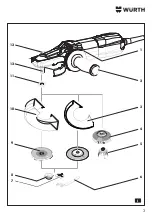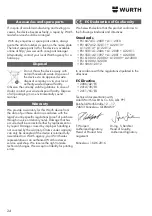
16
Special safety instructions
Safety Warnings Common for Grind-
ing, Sanding, Wire Brushing, and
Abrasive Cutting-Off Operations:
Application
a)
This electric tool is to be used as a
grinder, sander, wire brush and cut-off
grinder. Observe all the safety instruc-
tions, precautions, illustrations and data
supplied with the device.
Failure to observe
the following instructions can result in electric
shock, fire and/or serious injuries.
b)
This electric tool is not suitable for
polishing.
Uses for which the electric tool is not
intended may result in dangers and injuries.
c)
Do not use any accessories not specifi
-
cally intended or recommended for this
electric tool.
Just because the accessory can
be fitted to your electric tool does not mean that
it can be used safely.
d)
The permissible speed of the accessory
used must be at least as high as the
maximum speed indicated on the electric
tool.
Accessories that run faster than permitted
can burst and parts may fly around.
e)
Outside diameter and thickness of
the accessory used must conform to
the specifications of your electric tool.
Incorrectly dimensioned attachments cannot be
adequately shielded or controlled.
f)
Accessories with inserted thread must fit
exactly onto the grinding spindle of the
electric tool. With accessories attached
using a flange, the form of the flange
must fit exactly to the mounting boring.
At-
tachments that do not fit exactly onto the mounting
fixture of the electric tool rotate erratically, vibrate
very strongly and may lead to a loss of control.
g)
Do not use damaged accessories.
Before every use, inspect accessories
such as grinding wheels for splintering
and cracks, grinding discs for cracks or
severe wear and wire brushes for loose
or broken wires. If the electric tool or
accessory falls down, check whether
it is damaged or use an undamaged
accessory. When you have inspected
and fitted the accessory, keep yourself
and other persons in the vicinity outside
the plane of the rotating accessory and
allow the device to run at maximum
speed for one minute.
Damaged attachments
normally break during this test time.
h)
Wear personal protective equipment.
Depending on the application, use a full
face mask, eyeshield or protective gog-
gles. If appropriate, wear a dust mask,
hearing protection, protective gloves or
a special apron that protects you from
small grinding and material particles.
The eyes should be protected from flying foreign
matter that can occur during various applications.
The dust mask or face mask must be suitable for
filtering out the dust created during the applica
-
tion. If you are exposed to a loud noise for a pro-
longed period, you may suffer a loss of hearing.
i)
Ensure that other persons stay a safe
distance away from your working area.
Everyone entering the working area
must wear personal protective equip-
ment.
Broken pieces of the workpiece or broken
attachments can fly off and cause injuries even
outside the direct working area.
j)
Hold the device only at the insulated
handles when carrying out work where
the attachment could contact concealed
electricity cables or the mains lead of
the electric tool.
Contact with a live cable can
make metallic parts of the device live and may
lead to an electric shock.
k)
Keep the mains lead away from rotat-
ing attachments.
If you lose control over the device, the mains lead
may be severed or caught up and may pull your
hand or arm into the rotating attachment.
l)
Never put the electric tool down before
the attachment has come to a complete
standstill.
The rotating attachment may make
contact with the surface on which it is placed and
could cause you to lose control of the electric
tool.
m)
Do not allow the electric tool to run
while you are carrying it.
Your clothing
could come into contact with the rotating attach-
ment and cause the attachment to bore into your
body.
n)
Clean the ventilation slots of your elec-
tric tool at regular intervals.
The motor fan
draws dust into the housing, and a heavy accu-
mulation of metal dust may pose electric hazards.
o)
Do not use the electrical tool in the vicin-
ity of flammable materials.
Sparks could
cause these materials to ignite.
Summary of Contents for FKWS 9-125
Page 3: ...3 I 12 13 6 2 1 4 3 7 9 8 10 11 5...
Page 4: ...12 B A C 4 III II 14 3...
Page 111: ...111 GR Adolf W rth GmbH Co KG 3 1...
Page 112: ...112 a b c d e f g...
Page 113: ...113 h i j k l m n o p a...
Page 114: ...114 b c d e f g h i j k a b...
Page 115: ...115 c d e f a a b...
Page 116: ...116 FI FI P2 FI 30 mA...
Page 118: ...118 I II 1 2 3 4 5 6 7 8 9 10 11 12 13 14 2 II 3 4 mm 14 3 3 13...
Page 119: ...119 8 9 6 mm 7 6 8 8 12 8 8 8 6 III 11 3 9 11 III 7 7 7 7 6 7 6...
Page 120: ...120 1 1 30 40 W rth...
Page 193: ...193 BG Adolf W rth GmbH Co KG 3 1...
Page 194: ...194 a b c d e f g...
Page 195: ...195 h i j k l m n o p...
Page 196: ...196 a b c d e f g h i j a b...
Page 197: ...197 c d e f a a b...
Page 198: ...198 FI FI P2 30 mA...
Page 200: ...200 1 2 3 4 5 6 7 8 9 10 11 12 13 14 2 3 4 mm 14 3 3 13...
Page 201: ...201 8 9 6 mm 7 6 8 8 12 8 8 8 6 11 3 9 11 7 7 7 7 6 7 6...
Page 202: ...202 1 1 30 40 W rth...
Page 234: ...234 RU Adolf W rth GmbH Co KG 3 1...
Page 235: ...235 a b c d e f g...
Page 236: ...236 h i j k l m n o p a...
Page 237: ...237 b c d e f g h i j k a b c...
Page 238: ...238 d e f a a b...
Page 239: ...239 FI P2 30 A...
Page 241: ...241 I II 1 2 3 4 5 6 7 8 9 10 11 12 13 14 2 II 3 4 14 3 3...
Page 242: ...242 III 7 7 7 7 6 7 6 8 9 6 7 6 8 13 III 11 3 9 11...
Page 243: ...243 8 12 8 8 8 6 1 1 30 40...
Page 244: ...244 W rth 1 W rth masterService http www wuerth com partsmanager W rth...
















































